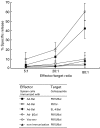Activation of HIV-1-specific immune responses to an HIV-1 vaccine constructed from a replication-defective adenovirus vector using various combinations of immunization protocols
- PMID: 11472406
- PMCID: PMC1906078
- DOI: 10.1046/j.1365-2249.2001.01540.x
Activation of HIV-1-specific immune responses to an HIV-1 vaccine constructed from a replication-defective adenovirus vector using various combinations of immunization protocols
Abstract
We constructed a recombinant replication defective adenovirus vector containing the env gene (Ad-Bal) derived from macrophage-trophic HIV-1 (HIV-1 Bal). We then immunized mice with this vector using several administration routes and protocols, and examined the immune response. When the Ad-Bal viral vector (over 1 x 10(7) pfu) was injected subcutaneously, both humoral and cell-mediated immunities were induced. However, immune response induced by the Ad-Bal vector alone was weaker than that induced by the recombinant vaccinia viral vector. We then employed the following three immunization protocols: (l) DNA vaccination followed by immunization with the Ad-Bal; (2) vaccination using the Ad-Bal vector followed by DNA vaccination; and (3) DNA vaccination followed by Ad-Bal infection and passive transfer of dendritic cells (DCs) infected with the Ad-Bal. Among the three protocols, the last gave the strongest humoral and cell-mediated immunity. These results suggest that the combination of DNA vaccination, Ad-Bal vector infection and passive transfer of Ad-Bal-infected DCs can induce strong immunity against HIV-1 Bal.
Figures





Similar articles
-
Long-term humoral and cellular immunity induced by a single immunization with replication-defective adenovirus recombinant vector.Eur J Immunol. 1995 Dec;25(12):3467-73. doi: 10.1002/eji.1830251239. Eur J Immunol. 1995. PMID: 8566039
-
Replication-deficient recombinant adenoviruses expressing the human immunodeficiency virus Env antigen can induce both humoral and CTL immune responses in mice.J Gen Virol. 1999 Oct;80 ( Pt 10):2621-2628. doi: 10.1099/0022-1317-80-10-2621. J Gen Virol. 1999. PMID: 10573155
-
Humoral, mucosal, and cellular immunity in response to a human immunodeficiency virus type 1 immunogen expressed by a Venezuelan equine encephalitis virus vaccine vector.J Virol. 1997 Apr;71(4):3031-8. doi: 10.1128/JVI.71.4.3031-3038.1997. J Virol. 1997. PMID: 9060663 Free PMC article.
-
Use of adenovirus in vaccines for HIV.Handb Exp Pharmacol. 2009;(188):275-93. doi: 10.1007/978-3-540-71029-5_13. Handb Exp Pharmacol. 2009. PMID: 19031031 Review.
-
Correlates of protective immunity against HIV-1 infection in immunized chimpanzees.Immunol Lett. 1996 Jun;51(1-2):121-4. doi: 10.1016/0165-2478(96)02565-5. Immunol Lett. 1996. PMID: 8811355 Review.
Cited by
-
An adenovirus type 5 (Ad5) amplicon-based packaging cell line for production of high-capacity helper-independent deltaE1-E2-E3-E4 Ad5 vectors.J Virol. 2005 May;79(10):6400-9. doi: 10.1128/JVI.79.10.6400-6409.2005. J Virol. 2005. PMID: 15858023 Free PMC article.
-
Potent, persistent induction and modulation of cellular immune responses in rhesus macaques primed with Ad5hr-simian immunodeficiency virus (SIV) env/rev, gag, and/or nef vaccines and boosted with SIV gp120.J Virol. 2003 Aug;77(16):8607-20. doi: 10.1128/jvi.77.16.8607-8620.2003. J Virol. 2003. PMID: 12885879 Free PMC article.
-
Adenoviruses as vaccine vectors.Mol Ther. 2004 Oct;10(4):616-29. doi: 10.1016/j.ymthe.2004.07.013. Mol Ther. 2004. PMID: 15451446 Free PMC article. Review.
-
Research advances in replication-deficient viral vector vaccines.Front Vet Sci. 2025 Mar 3;12:1535328. doi: 10.3389/fvets.2025.1535328. eCollection 2025. Front Vet Sci. 2025. PMID: 40098886 Free PMC article. Review.
-
Improved protection of rhesus macaques against intrarectal simian immunodeficiency virus SIV(mac251) challenge by a replication-competent Ad5hr-SIVenv/rev and Ad5hr-SIVgag recombinant priming/gp120 boosting regimen.J Virol. 2003 Aug;77(15):8354-65. doi: 10.1128/jvi.77.15.8354-8365.2003. J Virol. 2003. PMID: 12857905 Free PMC article.
References
-
- Jones N, Shenk T. Isolation of deletion and substitution mutants of adenovirus type 5. Cell. 1978;13:181–8. - PubMed
-
- Juillard V, Villefroy P, Godfrin D, et al. Long-term humoral and cellular immunity induced by a single immunization with replication-defective adenovirus recombinant vector. Eur J Immunol. 1995;12:3467–73. - PubMed
-
- Bartlett JS, Kleinschmidt J, Boucher RC, et al. Targeted adeno-associated virus vector transduction of nonpermissive cells mediated by a bispecific F (ab′gamma) 2 antibody. Nat Biotechnol. 1999;17:181–6. - PubMed
Publication types
MeSH terms
Substances
LinkOut - more resources
Full Text Sources
Other Literature Sources

